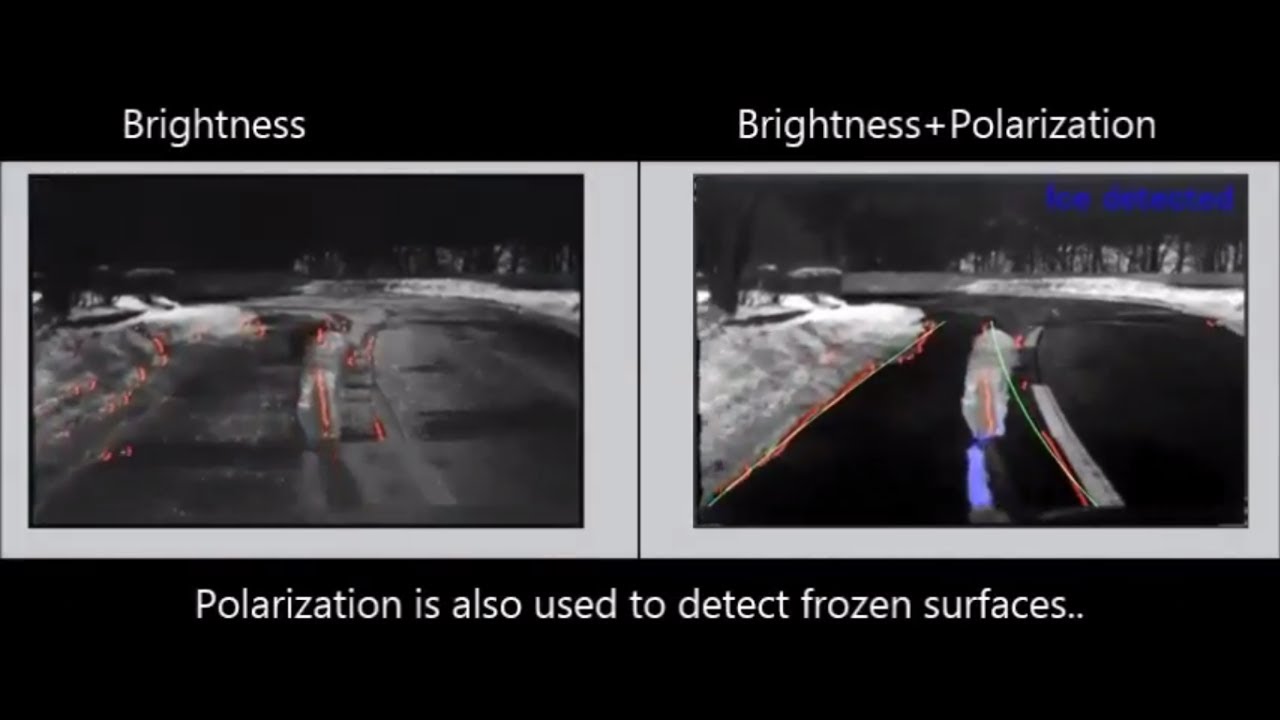- Home
- Technology
- Ricoh's Technology
- Frozen road detection
Frozen road detection
Background
At low temperature, water on the road freezes, making the surface slippery. This increases the risk of accidents.
The capability to detect a frozen road is useful in many ways. For instance, warning signs can be displayed for the driver; vehicle operation can be controlled to prevent skidding; and a snow-melting agent can be spread.
Several ideas have been presented to detect frozen roads. The basis can be road temperature detection, or a large-scale detector using the reflected light of a stationary laser. These ideas, however, have issues when detecting a wide area of freezing while the vehicle is traveling, or with the precision of identifying freezing.
Technical highlights
Ricoh has improved detection performance by using polarization and combining anomaly detection and deep learning.
Using polarization to detect road conditions
Light contains three types of information: amplitude (brightness), wavelength (color), and polarization.
Polarization cannot be detected with the human eye. Yet it is useful in detecting object shapes, surface conditions, and properties and angle of light.
Ricoh's polarization camera obtains polarization information in real time.
The polarization camera precisely detects the conditions of frozen road surfaces, which cannot be clarified by colors and brightness only.

The polarization camera detects the light reflected on the road surface, revealing surface conditions.
Having AI learn and improving detection rate
Recently, much effort has been put into research and development of artificial intelligence (AI), enabling machines to have a learning function.
The polarization camera captures a range of frozen road conditions. Some ice is like a mirror; some is slushy.
Generally speaking, to allow AI to learn something, you need to prepare everything beforehand. With frozen road detection, you need to identify and provide all the frozen states that should be detected.
Yet the conditions of frozen roads vary a lot. Preparing images for all conditions requires great effort.
Thus, Ricoh has adopted semi-supervised anomaly detection as the learning method.
This learning method uses only images of unfrozen roads – images of roads that are 100% free of freezing, for instance, those on sunny or rainy days.
Any abnormal values that depart from the norm (conditions that are observed neither on a sunny nor a rainy day) are determined as a freezing condition. This scheme allows the detection of unknown, different freezing conditions.
This method allows many sample images to be easily acquired. You can go on a drive and shoot images while the temperature is above a certain threshold, and all the images will be samples of unfrozen roads.

Deep learning for reducing misdetections
Generally speaking, precision tends to be low with semi-supervised anomaly detection where the information used refers only to a single state.
Thus, to increase precision, Ricoh has developed a new method that detects anomalies according to the learning results over a multi-layer neural network.
This method significantly reduces misdetections. When polarization images and brightness images are combined, the number of misdetections for the same detection rate is decreased by at least one digit from that when only brightness images are used.

When polarization information is combined with brightness information and deep learning is combined with machine learning, the detection rate rises and misdetections decrease.
Ricoh's vision
Ricoh will continue to exploit its technological resources, researching systems that precisely capture the surrounding conditions and generate feedback from them.
Related publications
- R. Kasahara, I. Itoh, and H. Hirai, “Improvement of image quality by polarization mixing,” SPIE OPTO. International Society for Optics and Photonics, 89920U (2014).
